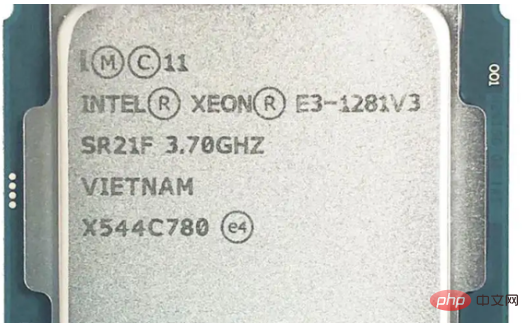
CPU main frequency is the clock frequency when the CPU core is working; the operation of the computer is executed step by step under the control of the clock signal. Each clock signal cycle completes one step of the operation. The level of the clock frequency reflects this to a large extent. In addition to the speed of the CPU, there is a certain relationship between the main frequency and the actual computing speed, but there is currently no definite formula that can quantify the numerical relationship between the two.

The operating environment of this tutorial: Windows 10 system, DELL G3 computer.
The main frequency of the CPU is the clock frequency at which the CPU core works (CPU Clock Speed).
What is usually said is the MHz of a certain CPU, and this MHz is the main frequency of the CPU. Many people think that the main frequency of a CPU is its running speed, but this is not the case. The main frequency of the CPU indicates the speed at which the digital pulse signal oscillates in the CPU, and has no direct relationship with the actual computing power of the CPU. There is a certain relationship between the main frequency and the actual computing speed, but there is currently no definite formula that can quantify the numerical relationship between the two, because the computing speed of the CPU also depends on the performance indicators of various aspects of the CPU's pipeline (cache, instruction set , number of CPU bits, etc.).
The main frequency is the clock frequency of the CPU. The operation of the computer is executed step by step under the control of the clock signal. Each clock signal cycle completes one step of the operation. The level of the clock frequency reflects the speed of the CPU to a large extent. Speed

Expand knowledge
Characteristics of CPU frequency
There is a certain relationship between the main frequency and the actual computing speed, but there is no definite formula that can quantify the numerical relationship between the two, because the computing speed of the CPU also depends on the performance indicators of various aspects of the CPU's pipeline (cache, cache, Instruction set, number of bits of CPU, etc.). Since the main frequency does not directly represent the computing speed, under certain circumstances, a CPU with a higher main frequency may have a lower actual computing speed. For example, most of AMD's AthlonFX series CPUs can achieve the higher frequency CPU performance of Intel's Pentium 4 series CPUs at lower clock speeds, so the AthlonFX series CPUs are named after PR values. Therefore, the main frequency is only one aspect of CPU performance and does not represent the overall performance of the CPU.
The main frequency of the CPU does not represent the speed of the CPU, but increasing the main frequency is crucial to increasing the CPU's computing speed. For example, assuming a CPU executes an arithmetic instruction in one clock cycle, when the CPU runs at a main frequency of 100MHz, it will be twice as fast as when it runs at a main frequency of 50MHz. Because the 100MHz clock cycle takes up half the time compared to the 50MHz clock cycle, that is, the time required for a CPU working at a 100MHz main frequency to execute an operation instruction is only 10 ns, which is half shorter than the 20 ns when working at a 50 MHz main frequency. Natural computing The speed is twice as fast. However, the overall running speed of the computer not only depends on the CPU computing speed, but also is related to the operation of other sub-systems. Only by increasing the main frequency, the running speed of each sub-system and the data transmission speed between sub-systems can be improved. After it is improved, the overall running speed of the computer can really be improved.
Increasing the CPU working frequency is mainly limited by the production process. Since the CPU is manufactured on a semiconductor silicon wafer, wires are required to connect the components on the silicon wafer. Under high-frequency conditions, the wires are required to be as thin and short as possible, so as to reduce stray interference such as wire distributed capacitance. To ensure that the CPU operation is correct. Therefore, the limitation of manufacturing process is one of the biggest obstacles to the development of CPU frequency.
When it comes to the main frequency of the processor, we must mention two closely related concepts: multiplier and FSB. The FSB is the base frequency of the CPU, and the unit is also MHz. The FSB is the speed at which the CPU and the motherboard run synchronously, and in most computer systems the FSB is also the speed at which the memory and the motherboard run synchronously. In this way, it can be understood that the FSB of the CPU is directly connected to the memory. pass to achieve a synchronous operating state between the two; the frequency multiplier is the multiple of the ratio of the main frequency and the external frequency. Main frequency, external frequency, multiplier, their relationship formula: main frequency = external frequency × multiplier. Early CPUs did not have the concept of "frequency multiplication". At that time, the main frequency and the speed of the system bus were the same.
With the development of technology, the speed of CPU is getting faster and faster, and accessories such as memory and hard disk can no longer keep up with the speed of CPU. The emergence of frequency multiplier solves this problem. It can make components such as memory still maintain the speed of CPU. It works at a relatively low system bus frequency, and the main frequency of the CPU can be infinitely increased through frequency multiplication (theoretically). We can think of the FSB as a production line in the machine, and the frequency multiplier is the number of production lines. The production speed of a machine (main frequency) is naturally the speed of the production line (FSB) multiplied by the number of production lines. (multiplier). Manufacturers have basically locked the multiplier. To overclock, the only way to overclock is to start with the FSB. By matching the multiplier and the FSB, you can set the jumpers on the motherboard or set soft overclocking in the BIOS, thereby partially improving the overall performance of the computer. So when buying, try to pay attention to the FSB of the CPU.
For more related knowledge, please visit the FAQ column!
The above is the detailed content of What is the main frequency of cpu. For more information, please follow other related articles on the PHP Chinese website!
 What to do if the CPU temperature is too high
What to do if the CPU temperature is too high
 A memory that can exchange information directly with the CPU is a
A memory that can exchange information directly with the CPU is a
 The main components that make up the CPU
The main components that make up the CPU
 What are the video server configuration parameters?
What are the video server configuration parameters?
 How to solve cpu fan error
How to solve cpu fan error
 What to do if the CPU usage is too high
What to do if the CPU usage is too high
 Introduction to CPU performance index parameters
Introduction to CPU performance index parameters
 c++ code running tutorial
c++ code running tutorial
 What to do if the Bluetooth switch is missing in Windows 10
What to do if the Bluetooth switch is missing in Windows 10